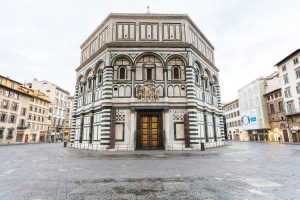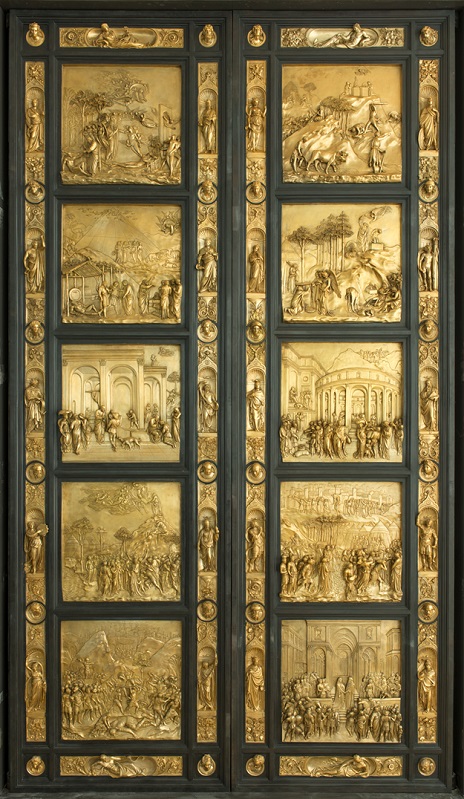Monsignor Timothy Verdon of Florence, Italy, to Bless Doors in October
Kansas City, MO Sept. 7, 2017 – Following a dramatic, successful installation in Bloch Lobby, The Gates of Paradise will officially open to the public on Friday, Sept. 8, giving visitors to The Nelson-Atkins Museum of Art a view of the massive pair of doors that are considered the defining moment of the Italian Renaissance. The 17-foot gilded doors, the promised gift of museum Trustee Paul DeBruce and his wife, Linda Woodsmall-DeBruce, are casts of the original doors created in the 15th-century workshop of sculptor and artist Lorenzo Ghiberti.

The Gates of Paradise were created originally for the east façade of the Baptistery in Florence, Italy. Monsignor Timothy Verdon, Director of the prize-winning Museo dell’Opera del Duomo in Florence, will be in Kansas City in October to view and bless the doors at the Nelson-Atkins. He will present a lecture in Atkins Auditorium at 6 p.m. Wednesday, Oct. 25. Monsignor Verdon is a Roman Catholic priest, Canon of Florence Cathedral, and a professional art historian with a PhD from Yale University.
The massive bronze doors were installed this summer at the Nelson-Atkins by a team of engineers and workers who met multiple challenges in moving the 4 ½-ton doors into the museum and hoisting them into place. The doors require a location that allows for anchoring and framing against a strong wall, and the top of the ramp in Bloch Lobby offered just such a majestic location.
The original Gates of Paradise were set within the east portal of the Baptistery in Florence, and they functioned as a space of transition through which the baptized passed on their way to the Cathedral, which signified the Heavenly Kingdom to believers.
“Bloch Lobby is the entry point for the museum, and The Gates of Paradise will signal that as visitors enter the modern and ethereal Bloch Building, they will encounter not only contemporary work, but also art from all over the world and across many time periods,” said Julián Zugazagoitia, Menefee D. and Mary Louise Blackwell CEO & Director of the Nelson-Atkins.
 Ghiberti was commissioned in 1425 to create the doors, and he and his workshop toiled for 27 years (1425-1452) to create striking, sculptural panels depicting scenes from the Old Testament. The panels are surrounded by intricate framework, foliage, fruit and busts. For centuries, the doors have been considered one of the masterpieces of Western art and the beginning of the Renaissance.
Ghiberti was commissioned in 1425 to create the doors, and he and his workshop toiled for 27 years (1425-1452) to create striking, sculptural panels depicting scenes from the Old Testament. The panels are surrounded by intricate framework, foliage, fruit and busts. For centuries, the doors have been considered one of the masterpieces of Western art and the beginning of the Renaissance.
“The original doors represented a transition to the Italian Renaissance, which was so fundamentally transformative that its influence left no Western culture untouched,” Zugazagoitia said.
The contemporary cast of Ghiberti’s Gates of Paradise fits within a long trajectory and tradition of copying great works of art from the past, extending to Antiquity. Romans filled their homes and their bathhouses with copies of Greek sculptures. Renaissance collectors including Cosimo I de Medici, and Antoine Perrenot de Granvelle, whose portrait by Titian hangs in the Nelson-Atkins, commissioned bronze copies of sculptures for their private collections. The practice continued in the 18th century among English collectors including the Duke of Hamilton, the Duke and Duchess of Lauderdale, and the Duke of Northumberland, all of whom commissioned marble replicas of the most important Italian works they saw during their travels on the Grand Tour.
In the 19th and early 20th centuries, museums throughout Europe and America, including the Victoria and Albert Museum in London, and The Metropolitan Museum of Art in New York, assembled vast collections of plaster casts of Classical and Renaissance sculptures created from molds taken directly from the originals to educate and as a way to disseminate knowledge. William Rockhill Nelson participated in this trend from the early 20th century and acquired a small collection of sculpture casts, which he displayed in a gallery on the second floor of the Kansas City Public Library. Such plaster casts provided museum visitors – many of whom found travel to Europe difficult – the only opportunity to experience the extraordinary power of great masterpieces of Western Art. Mr. Nelson also commissioned copies of paintings by the “European Old Masters,” works that he felt “have stood the test of time and are acclaimed as the foremost achievements.”

The contemporary bronze casts of Ghiberti’s Gates of Paradise at the Nelson-Atkins offers visitors another opportunity to see a monumentally important work of art in its original scale and materiality. It is one of two authorized casts made in 1990 from molds taken by Bruno Bearzi in the late 1940s, directly from Ghiberti’s original. The casting process was organized to preserve the original and was fully monitored by the Ufficio Tecnico dell’Opera di Santa Maria del Fiore and carried out by the Fonderia Marinelli of Florence. The “sister” cast on view at the museum is the one in the east portal of the Florence Baptistery, replacing Ghiberti’s original doors, which are now on display inside the Museo dell’Opera del Duomo.
Between 2013 and 2016, the new casts of The Gates of Paradise traveled in an exhibition tour that included Mumbai, India and Seoul, South Korea. On returning to Florence, they were purchased by the DeBruces as a promised gift for the Nelson-Atkins. The massive gates were crated, sent on a ship across the ocean, and transported to Kansas City, arriving in February of this year.
Images:
Monsignor Timothy Verdon of Florence, Italy
The Gates of Paradise are now installed in Bloch Lobby at the Nelson-Atkins.
The Gates of Paradise grace the east doors of the Baptistery in Florence. Photo provided by Alamy Stock Photos.
The Nelson-Atkins Museum of Art
The Nelson-Atkins in Kansas City is recognized nationally and internationally as one of America’s finest art museums. The museum, which strives to be the place where the power of art engages the spirit of community, opens its doors free of charge to people of all backgrounds. The museum is an institution that both challenges and comforts, that both inspires and soothes, and it is a destination for inspiration, reflection and connecting with others.
The Nelson-Atkins serves the community by providing access to its renowned collection of nearly 40,000 art objects and is best known for its Asian art, European and American paintings, photography, modern sculpture, and new American Indian and Egyptian galleries. Housing a major art research library and the Ford Learning Center, the Museum is a key educational resource for the region. In 2017, the Nelson-Atkins celebrates the 10-year anniversary of the Bloch Building, a critically acclaimed addition to the original 1933 Nelson-Atkins Building.
The Nelson-Atkins is located at 45th and Oak Streets, Kansas City, MO. Hours are Wednesday, 10 a.m.–5 p.m.; Thursday/Friday, 10 a.m.–9 p.m.; Saturday, 10 a.m.–5 p.m.; Sunday, 10 a.m.–5 p.m. Admission to the museum is free to everyone. For museum information, phone 816.751.1ART (1278) or visit nelson-atkins.org.
For media interested in receiving further information, please contact:
Kathleen Leighton, Manager, Media Relations and Video Production
The Nelson-Atkins Museum of Art
816.751.1321
kleighton@nelson-atkins.org
